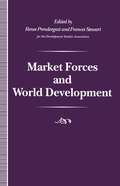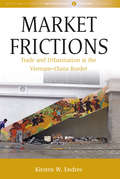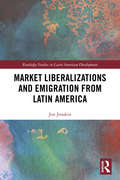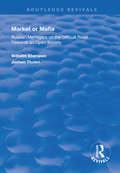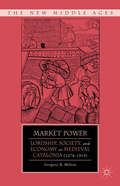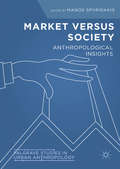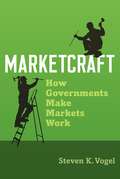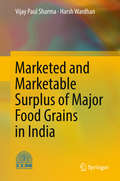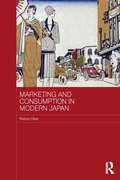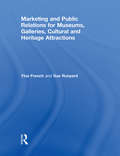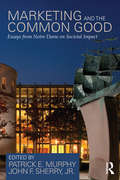- Table View
- List View
Market Entry in Japan: Theory and Management in a Turbulent Era
by René Haak Ulrike HaakAn essential guide to the current state of Market Entry in Japan that illustrates the challenges, opportunities and routes to successfully doing business in Japan. It offers a short but scientifically well-founded overview of the ways into the Japanese market that promise success.
Market Forces and World Development
by Renee Prendergast Frances StewartThe increasing liberalization and globalisation of the world economy has not been accompanied by covergence in the various indicators of economic and social development. The papers in this volume go some way towards explaining why the increasing reliance on market forces may lead to greater divergences in economic performance. They also point to the importance for the development process of social solidarity and institutions which encourage co-operative approaches to problem solving.
Market Frictions: Trade and Urbanization at the Vietnam-China Border (Max Planck Studies in Anthropology and Economy #5)
by Kirsten W. EndresBased on ethnographic research conducted over several years, Market Frictions examines the tensions and frictions that emerge from the interaction of global market forces, urban planning policies, and small-scale trading activities in the Vietnamese border city of Lào Cai. Here, it is revealed how small-scale traders and market vendors experience the marketplace, reflect upon their trading activities, and negotiate current state policies and regulations. It shows how “traditional” Vietnamese marketplaces have continually been reshaped and adapted to meet the changing political-economic circumstances and civilizational ideals of the time.
Market Liberalizations and Emigration from Latin America (Routledge Studies in Latin American Development)
by Jon JonakinMarket Liberalizations and Emigration From Latin America provides a comprehensive analysis of the impact of the era of liberalization in Latin America, focusing in particular on labor markets and emigration from the region. Starting in 1980, liberalization in Latin America was expected to improve market functioning, efficiency, and welfare. Instead, it yielded slower growth, unexpectedly high levels of unemployment and income inequality, flat or falling wages, an increase in non-tradeable (service sector) and informal activity, and, finally, waves of emigration from Mexico, Central America, and Ecuador, among other countries. This book provides a heterodox narrative explanation of why the orthodox economic model that underwrote the standard ‘trickle-down’ account served more to obscure and obfuscate than to explain and clarify the state-of-affairs. The book investigates the impact of the global-scale liberalizations of markets for goods and physical and finance capital and the mere national-scale liberalization of regional labor markets, arguing that these asymmetric liberalizations, together, resulted in labor market failure and contributed in turn to the subsequent, undocumented migrant flow. The ultimate effect of the skewed scale of market liberalizations in Latin America disproportionately benefited capital at the expense of labor. Market Liberalizations and Emigration From Latin America will be of interest to researchers of economics and development in Latin America.
Market Liberalizations and Emigration from Latin America (Routledge Studies in Latin American Development)
by Jon JonakinMarket Liberalizations and Emigration From Latin America provides a comprehensive analysis of the impact of the era of liberalization in Latin America, focusing in particular on labor markets and emigration from the region. Starting in 1980, liberalization in Latin America was expected to improve market functioning, efficiency, and welfare. Instead, it yielded slower growth, unexpectedly high levels of unemployment and income inequality, flat or falling wages, an increase in non-tradeable (service sector) and informal activity, and, finally, waves of emigration from Mexico, Central America, and Ecuador, among other countries. This book provides a heterodox narrative explanation of why the orthodox economic model that underwrote the standard ‘trickle-down’ account served more to obscure and obfuscate than to explain and clarify the state-of-affairs. The book investigates the impact of the global-scale liberalizations of markets for goods and physical and finance capital and the mere national-scale liberalization of regional labor markets, arguing that these asymmetric liberalizations, together, resulted in labor market failure and contributed in turn to the subsequent, undocumented migrant flow. The ultimate effect of the skewed scale of market liberalizations in Latin America disproportionately benefited capital at the expense of labor. Market Liberalizations and Emigration From Latin America will be of interest to researchers of economics and development in Latin America.
Market Movements: African American Involvement in School Voucher Reform (Critical Social Thought)
by Thomas C. PedroniWinner of the 2009 Critics Choice Book Award of the American Educational Studies Association (AESA) Through careful ethnographic research, Market Movements represents community leaders, school officials, and most importantly, African American working class families who have used vouchers as a means of removing their children from public schools they deemed unacceptable. The book works to discern the overlaps and tensions between the educational visions of African American voucher families and those of powerful conservative educational forces in U.S. society which purport to be allied with them. To the extent that there are points of divergence with the educational right, and points of convergence with educational progressives, this book provides a hopeful message and a practical vision. It seeks to accomplish some of the critical empirical and conceptual groundwork that is necessary in order to renew the increasingly fractious relations between those social actors—teachers, communities of color, critical researchers, and labor unions—most likely to defend and expand previous social democratic victories.
Market Movements: African American Involvement in School Voucher Reform (Critical Social Thought)
by Thomas C. PedroniWinner of the 2009 Critics Choice Book Award of the American Educational Studies Association (AESA) Through careful ethnographic research, Market Movements represents community leaders, school officials, and most importantly, African American working class families who have used vouchers as a means of removing their children from public schools they deemed unacceptable. The book works to discern the overlaps and tensions between the educational visions of African American voucher families and those of powerful conservative educational forces in U.S. society which purport to be allied with them. To the extent that there are points of divergence with the educational right, and points of convergence with educational progressives, this book provides a hopeful message and a practical vision. It seeks to accomplish some of the critical empirical and conceptual groundwork that is necessary in order to renew the increasingly fractious relations between those social actors—teachers, communities of color, critical researchers, and labor unions—most likely to defend and expand previous social democratic victories.
Market or Mafia: Russian Managers on the Difficult Road Towards an Open Society (Routledge Revivals)
by Wilhelm Eberwein Jochen TholenFirst published in 1997 in the wake of the collapse of the Soviet Union, this volume examines the situation of Russian managers in the transition to a more capitalist and democratic system. It asks whether a country of eleven time zones, extreme climatic conditions from arctic temperatures to dry stone and sand deserts, with more than a hundred nationalities and limited experience with liberal ideas and concepts or with civil-democratic traditions can be ruled in a modern world. The differences between ‘Westies’ and ‘Slavophiles’ only complicate its situation further. Further still, the authors note significant similarities between notions of national betrayal related to the withdrawal of the victorious Red Army from Central and Eastern Europe and attitudes in 1920s Germany towards World War I. The immense responsibility carried by the company directors, entrepreneurs and managers of Russia for the future of their country is the focus of this book. It follows two other volumes on Germany (1990) and an Anglo-German comparison related to Western European integration (1993).
Market or Mafia: Russian Managers on the Difficult Road Towards an Open Society (Routledge Revivals)
by Wilhelm Eberwein Jochen TholenFirst published in 1997 in the wake of the collapse of the Soviet Union, this volume examines the situation of Russian managers in the transition to a more capitalist and democratic system. It asks whether a country of eleven time zones, extreme climatic conditions from arctic temperatures to dry stone and sand deserts, with more than a hundred nationalities and limited experience with liberal ideas and concepts or with civil-democratic traditions can be ruled in a modern world. The differences between ‘Westies’ and ‘Slavophiles’ only complicate its situation further. Further still, the authors note significant similarities between notions of national betrayal related to the withdrawal of the victorious Red Army from Central and Eastern Europe and attitudes in 1920s Germany towards World War I. The immense responsibility carried by the company directors, entrepreneurs and managers of Russia for the future of their country is the focus of this book. It follows two other volumes on Germany (1990) and an Anglo-German comparison related to Western European integration (1993).
Market Power: Lordship, Society, and Economy in Medieval Catalonia (1276–1313) (The New Middle Ages)
by G. MiltonMarket Power explores society and economy in medieval Iberia, examining the intersection of regional commercial interests, lordship, and royal authority as part of the evolution of a small village into a rural market town.
Market relations and the competitive process (New Dynamics of Innovation and Competition)
by Stan Metcalfe Alan WardeThere has been increasing interest and debate in recent years on the instituted nature of economic processes in general and the related ideas of the market, in particular the competitive process. This debate lies at the interface between two largely independent disciplines, economics and sociology, and reflects an attempt to bring the two fields of discourse more closely together. This book, newly available in paperback, explores this interface in a number of ways, looking at the competitive process and market relations from a number of different perspectives. It includes a wide range of contributors, most of whom are leading writers and thinkers in the field. The book considers the social role of economic institutions in society and examines the various meanings embedded in the word 'markets', as well as developing arguments on the nature of competition as an instituted economic process, rather than as competition being something that disturbs norms or institutions. It goes on to consider the deeper and more involved connection between markets and cognition, explaining how institutions can ease cognitive difficulties, and the effect of culture on markets and competition is also fully studied. This book will be of vital use to students and academics working in the fields of economics, sociology and business studies. It sketches the agenda for future research about markets and the competitive process.
Market Versus Society: Anthropological Insights (Palgrave Studies in Urban Anthropology)
by Manos SpyridakisThis volume addresses the fraught relationship between market and society in times of social and economic crisis, exploring how they interact in key social, cultural, and political arenas on a global scale. The contributors examine the neoliberal market in anthropological and ethnographic terms to question whether “market logic” has won out against social aspects of human existence in a framework of minimal state protection and the devaluation of human labor. Fruitfully combining empirical data and theoretical approaches, the volume investigates the extent to which ordinary people accept unequal allocations of resources and examines their sense of belonging in an expansive neoliberal economy.
Market Versus Society: Anthropological Insights (Palgrave Studies in Urban Anthropology)
by Manos SpyridakisThis volume addresses the fraught relationship between market and society in times of social and economic crisis, exploring how they interact in key social, cultural, and political arenas on a global scale. The contributors examine the neoliberal market in anthropological and ethnographic terms to question whether “market logic” has won out against social aspects of human existence in a framework of minimal state protection and the devaluation of human labor. Fruitfully combining empirical data and theoretical approaches, the volume investigates the extent to which ordinary people accept unequal allocations of resources and examines their sense of belonging in an expansive neoliberal economy.
Marketcraft: How Governments Make Markets Work
by Steven K. VogelModern-day markets do not arise spontaneously or evolve naturally. Rather they are crafted by individuals, firms, and most of all, by governments. Thus "marketcraft" represents a core function of government comparable to statecraft and requires considerable artistry to govern markets effectively. Just as real-world statecraft can be masterful or muddled, so it is with marketcraft. In Marketcraft, Steven Vogel builds his argument upon the recognition that all markets are crafted then systematically explores the implications for analysis and policy. In modern societies, there is no such thing as a free market. Markets are institutions, and contemporary markets are all heavily regulated. The "free market revolution" that began in the 1980s did not see a deregulation of markets, but rather a re-regulation. Vogel looks at a wide range of policy issues to support this concept, focusing in particular on the US and Japan. He examines how the US, the "freest" market economy, is actually among the most heavily regulated advanced economies, while Japan's effort to liberalize its economy counterintuitively expanded the government's role in practice. Marketcraft demonstrates that market institutions need government to function, and in increasingly complex economies, governance itself must feature equally complex policy tools if it is to meet the task. In our era-and despite what anti-government ideologues contend-governmental officials, regardless of party affiliation, should be trained in marketcraft just as much as in statecraft.
Marketcraft: How Governments Make Markets Work
by Steven K. VogelModern-day markets do not arise spontaneously or evolve naturally. Rather they are crafted by individuals, firms, and most of all, by governments. Thus "marketcraft" represents a core function of government comparable to statecraft and requires considerable artistry to govern markets effectively. Just as real-world statecraft can be masterful or muddled, so it is with marketcraft. In Marketcraft, Steven Vogel builds his argument upon the recognition that all markets are crafted then systematically explores the implications for analysis and policy. In modern societies, there is no such thing as a free market. Markets are institutions, and contemporary markets are all heavily regulated. The "free market revolution" that began in the 1980s did not see a deregulation of markets, but rather a re-regulation. Vogel looks at a wide range of policy issues to support this concept, focusing in particular on the US and Japan. He examines how the US, the "freest" market economy, is actually among the most heavily regulated advanced economies, while Japan's effort to liberalize its economy counterintuitively expanded the government's role in practice. Marketcraft demonstrates that market institutions need government to function, and in increasingly complex economies, governance itself must feature equally complex policy tools if it is to meet the task. In our era-and despite what anti-government ideologues contend-governmental officials, regardless of party affiliation, should be trained in marketcraft just as much as in statecraft.
Marketed and Marketable Surplus of Major Food Grains in India
by Vijay Paul Sharma Harsh WardhanThis book helps readers understand the concepts of marketed and marketable surplus, as well as the role of the government and marketing agencies, including those in the private sector, in improving market efficiency. It also examines the impact of various socioeconomic, technological, institutional, infrastructure, and price factors on the marketed surplus of major crops. While Indian agriculture has become increasingly market-oriented and monetized, the importance of market orientation of agriculture is also being recognized at the international level. The proportion of agricultural production that is marketed by farmers has increased significantly over the last few decades in India: in the early 1950s, about 30–35 per cent of food grains output was marketed, which has now increased to more than 70 per cent. In this context, the marketed surplus is proportionately higher in the case of commercial crops than subsistence crops. Recognizing its importance, the Government of India initiated a nation-wide survey to estimate marketable surplus and post-harvest losses in the early 1970s, which continued up to the late 1990s. As Indian agriculture, has undergone significant transformation, and no reliable estimates of marketed and marketable surplus are available, the study was conducted to estimate the marketed and marketable surplus of major food crops in leading producing states, and to examine important factors which determine the level of marketed surplus for various categories of farms. The results of this study offer a valuable resource for designing effective food procurement, distribution and price policies. Further, they provide reliable estimates of household farm retention pattern for self-consumption, seed, feed, wages and other payments in kind, which can be used as the basis for planning infrastructure development of storage and distribution. This essential information can help policy-makers determine how much marketed surplus is generated by the different categories of farmers and how marketable surplus would respond to changes in diverse economic and non-economic variables, allowing them to design policies accordingly.
Marketing and American Consumer Culture: A Cultural Studies Analysis
by Arthur Asa BergerThis book offers a cultural studies approach to marketing and advertising and shows readers how scholars from different academic disciplines make sense of marketing’s role in American culture and society. It is written in an accessible style and has numerous drawings by the author to give it more visual interest.
Marketing and Consumption in Modern Japan (Routledge Studies in the Growth Economies of Asia)
by Kazuo UsuiThis book explores the development in Japan throughout the twentieth century of marketing and consumerism. It shows how Japan had a long established indigenous traditional approach to marketing, separate from Western approaches to marketing, and discusses how the Japanese approach to marketing was applied in the form of new marketing activities, which, responding to changing patterns of consumption, contributed considerably to Japan's economic success. The book concludes with a discussion of how Japanese approach to marketing is likely to develop at a time when globalisation and international marketing are having an increasing impact in Japan.
Marketing and Consumption in Modern Japan (Routledge Studies in the Growth Economies of Asia)
by Kazuo UsuiThis book explores the development in Japan throughout the twentieth century of marketing and consumerism. It shows how Japan had a long established indigenous traditional approach to marketing, separate from Western approaches to marketing, and discusses how the Japanese approach to marketing was applied in the form of new marketing activities, which, responding to changing patterns of consumption, contributed considerably to Japan's economic success. The book concludes with a discussion of how Japanese approach to marketing is likely to develop at a time when globalisation and international marketing are having an increasing impact in Japan.
Marketing and Public Relations for Museums, Galleries, Cultural and Heritage Attractions
by Ylva French Sue RunyardVisitors to museums, galleries, heritage sites and other not for profit attractions receive their information in changing ways. Communications channels are shifting and developing all the time, presenting new challenges to cultural PR and Marketing teams. Marketing and Public Relations for Museums, Galleries, Cultural and Heritage Attractions, as well as providing some of the theory of marketing, provides the latest available case studies coupled with comments and advice from professionals inside and outside the cultural sector to describe the possibilities and outline strategies for the future. A strong theme of change runs through each chapter. The economic climate is already affecting the publicly funded sectors and business and private sponsorship. How will it change over the next few years? The print media is contracting; reading and viewing patterns are changing as online and mobile media grow. What are the trends here, in Europe, US and elsewhere? Sustainability and global warming are not just buzz words but will have a real impact on public and private institutions and their visitor patterns. Population patterns are also changing with new immigrants arriving and the proportion of over 60s increases in Western countries. Cultural tourism has enjoyed a great surge in popularity and huge investments are being made in museums, galleries and events. Marketing and PR play a crucial role in the success of such ventures and will be illustrated with case studies from the UK, US, Canada, Australia, Middle East and China. Marketing and Public Relations for Museums, Galleries, Cultural and Heritage Attractions is aimed at students of marketing, museums, culture and heritage as well as professionals working in a range of cultural organisations from small to large and at different stages of market development from new entrants to those offering mature products. This includes museums, galleries, heritage and visitor attractions, community organisations, as well as organisers of festivals, markets, craft fairs and temporary exhibitions.
Marketing and Public Relations for Museums, Galleries, Cultural and Heritage Attractions
by Ylva French Sue RunyardVisitors to museums, galleries, heritage sites and other not for profit attractions receive their information in changing ways. Communications channels are shifting and developing all the time, presenting new challenges to cultural PR and Marketing teams. Marketing and Public Relations for Museums, Galleries, Cultural and Heritage Attractions, as well as providing some of the theory of marketing, provides the latest available case studies coupled with comments and advice from professionals inside and outside the cultural sector to describe the possibilities and outline strategies for the future. A strong theme of change runs through each chapter. The economic climate is already affecting the publicly funded sectors and business and private sponsorship. How will it change over the next few years? The print media is contracting; reading and viewing patterns are changing as online and mobile media grow. What are the trends here, in Europe, US and elsewhere? Sustainability and global warming are not just buzz words but will have a real impact on public and private institutions and their visitor patterns. Population patterns are also changing with new immigrants arriving and the proportion of over 60s increases in Western countries. Cultural tourism has enjoyed a great surge in popularity and huge investments are being made in museums, galleries and events. Marketing and PR play a crucial role in the success of such ventures and will be illustrated with case studies from the UK, US, Canada, Australia, Middle East and China. Marketing and Public Relations for Museums, Galleries, Cultural and Heritage Attractions is aimed at students of marketing, museums, culture and heritage as well as professionals working in a range of cultural organisations from small to large and at different stages of market development from new entrants to those offering mature products. This includes museums, galleries, heritage and visitor attractions, community organisations, as well as organisers of festivals, markets, craft fairs and temporary exhibitions.
Marketing and the Common Good: Essays from Notre Dame on Societal Impact
by Patrick E. Murphy John F. SherryMarketing is among the most powerful cultural forces at work in the contemporary world, affecting not merely consumer behaviour, but almost every aspect of human behaviour. While the potential for marketing both to promote and threaten societal well-being has been a perennial focus of inquiry, the current global intellectual and political climate has lent this topic extra gravitas. Through original research and scholarship from the influential Mendoza School of Business, this book looks at marketing’s ramifications far beyond simple economic exchange. It addresses four major topic areas: societal aspects of marketing and consumption; the social and ethical thought; sustainability; and public policy issues, in order to explore the wider relationship of marketing within the ethical and moral economy and its implications for the common good. By bringing together the wide-ranging and interdisciplinary contributions, it provides a uniquely comprehensive and challenging exploration of some of the most pressing themes for business and society today.
Marketing and the Common Good: Essays from Notre Dame on Societal Impact
by Patrick E. Murphy John F. Sherry Jr.Marketing is among the most powerful cultural forces at work in the contemporary world, affecting not merely consumer behaviour, but almost every aspect of human behaviour. While the potential for marketing both to promote and threaten societal well-being has been a perennial focus of inquiry, the current global intellectual and political climate has lent this topic extra gravitas. Through original research and scholarship from the influential Mendoza School of Business, this book looks at marketing’s ramifications far beyond simple economic exchange. It addresses four major topic areas: societal aspects of marketing and consumption; the social and ethical thought; sustainability; and public policy issues, in order to explore the wider relationship of marketing within the ethical and moral economy and its implications for the common good. By bringing together the wide-ranging and interdisciplinary contributions, it provides a uniquely comprehensive and challenging exploration of some of the most pressing themes for business and society today.
Marketing Competences and Strategic Flexibility in China
by Y. Wang R. Li-HuaToday's China presents a unique setting for organizations. Through an examination of current Chinese business, this book addresses its business culture and environment. In particular, it considers how firms build distinctive capabilities of organizational learning and strategic flexibility to achieve superior customer-focused performance.
Marketing Cultural and Heritage Tourism: A World of Opportunity (Museum Store Association)
by Rosemary Rice McCormickInnovative tourism industry leader Rosemary Rice McCormick guides the reader through the basics of marketing and tourism know-how for museum store managers and other museum and heritage marketing professionals. Packed with valuable ideas and case studies, you will learn how to build your business in the fast-growing, global tourism market, increase museum visitation and museum store sales, leverage business partnerships and tap into that “drive market” that comprises 85% of US travelers. This valuable resource is a must for all those in the business of connecting people with the cultural wealth of our museums and parks. The book received a 2011 SASI-ONE Gold Award.

